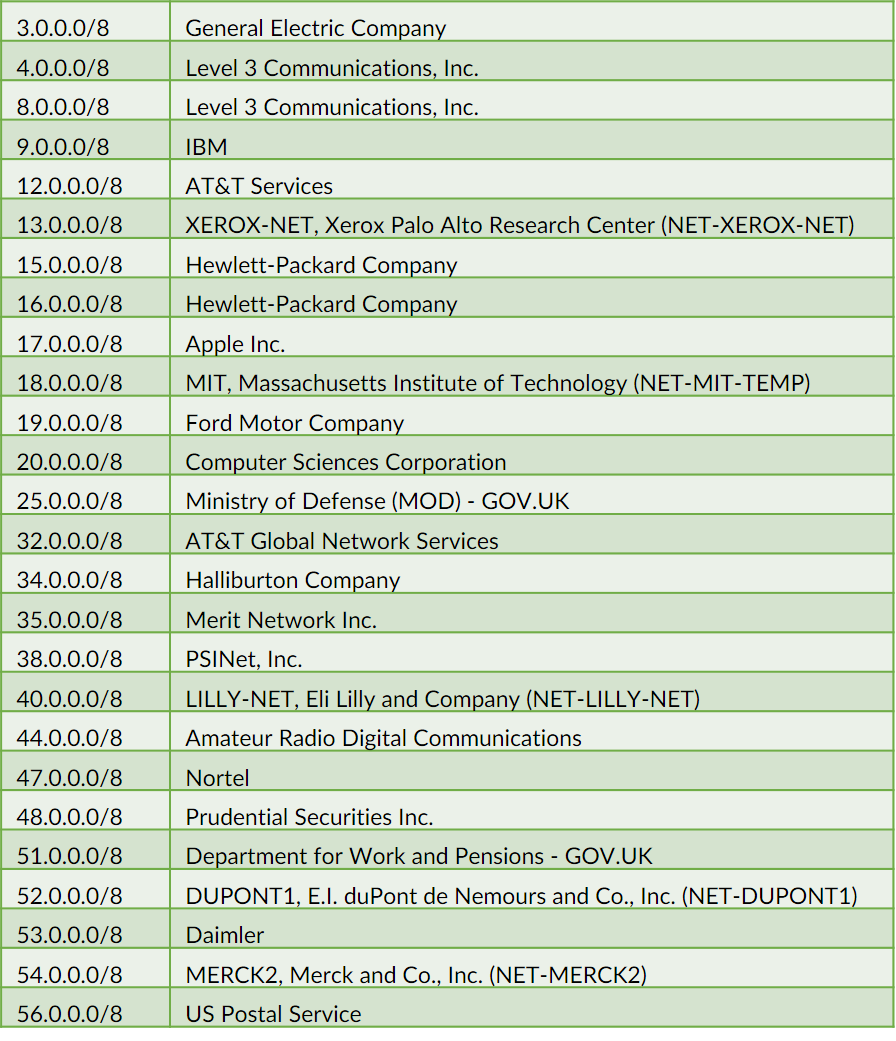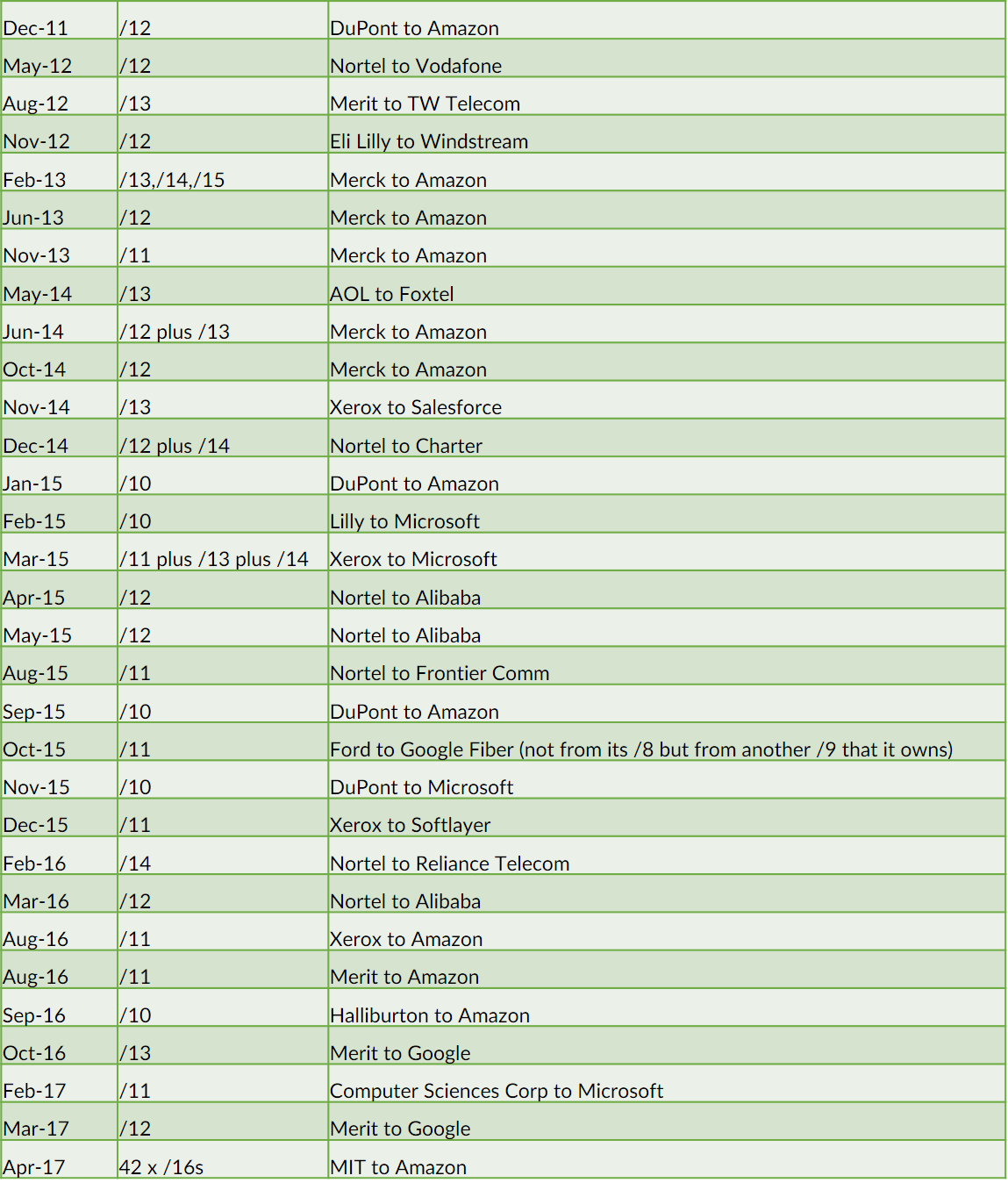This is a dormant blog. To see what I’ve been up to here is some stuff over on netaxis.be, philosopherontap.com, trefsgreenhouse.com, annesvans.com and beyondthewoods.co.uk
2017 has been a good year
Things have quietened down on the trefor.net front. When I was at Timico is used to write quite prolifically (2,748 published posts and 11,426 approved comments) and then after “semi-retiring” I continued with a view to making the blog a money maker. It was possible to make money through the vehicle – sponsorship for workshop, dinners and for themed weeks but hard work and I wasn’t that bothered. So I throttled back.
One thing led to another and I ended up setting up Netaxis Solutions UK. This has been done in conjunction with Netaxis in Belgium. Netaxis as some of you may already know are a Systems Integrator who boast most of the Tier 1 and Tier 2 telcos in Benelux as customers together with a number of major international players.
The company has got off to a good start and 2018 is looking as if it will build on this.We haven’t got a very sophisticated marketing function. In fact we haven’t got a marketing function. Were primarily a bunch of engineers doing stuff. However this will change. Instead of writing more for trefor.net I’m likely to concentrate on building up a Netaxis blog. They have tons of things to say. Really interesting things if you are a telco.
For the moment I’m keeping my powder dry but look out for do look out for snippets as they appear – more likely to see them on LinkedIn and netaxis.be than here but that is fine. I’m quite impressed with how LinkedIn has emerged as a business tool. I seem to have two communities of friends in the work sphere. The internet plumbing side all talk on Facebook and really don’t have anything to do with sales there unless it is B2C. However LinkedIn is it for the telco business.
In one sense to work it properly you need to work sites like LinkedIn on a full time basis. We can’t do that and if we did I don’t think we could cope with the level of interest it might generate at this stage. Without really doing any marketing we are pretty much flat out. Indeed we have engineering vacancies if you are interested (inc this one for a carrier presales eng).
Our business is a niche but it is a huge niche. It’s odd to compare it with my non telecom business interests (JoeFest & Anne’s Vans) and my creative writing at philosopherontap.com. How can a person get excited about telco nuts and bolts and internet plumbing (lonap.net). Both involve deep technicals that are only of interest to a limited few. Funny really considering our whole world relies on them working smoothly. Life is short. You have to do stuff.
Anyway this is a bit of a rambling way to getting to the point which is to wish you and yours an extremely good Christmas break. Come back fat and refreshed for the new year at which point you can pay for it all:)
Ciao amigos…
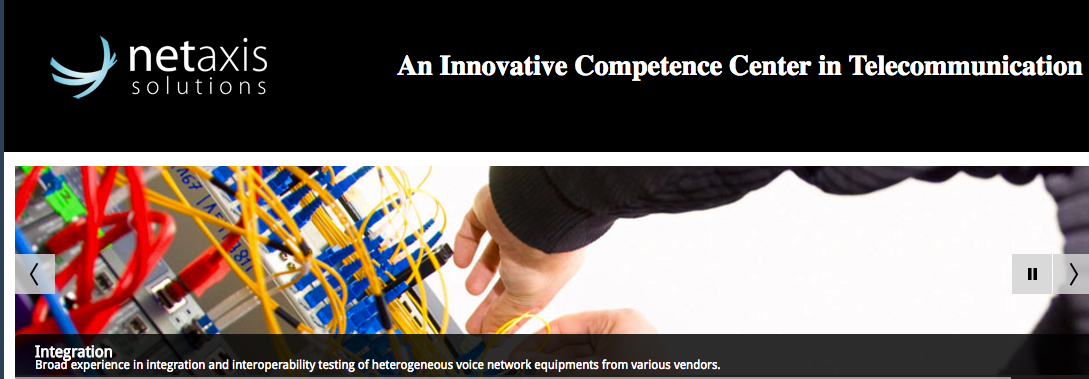
VoIP Carrier pre-sales engineer
Netaxis are a rapidly growing Telecoms Systems Integrator with their own in house software development team. Partner solutions from Oracle, Genband, Sonus, Broadsoft etc are combined with our own suite of products that include Network Monitoring, Call simulation, anti-fraud, Session Routing Engines, API Orchestration, Video and WebRTC solutions.
In their Benelux home territories Netaxis sell to most Tier 1 and 2 telcos and the company is now successfully expanding in other European markets including France, Italy and the UK and also around the globe with customers in Asia and Africa.
The company is now looking for a UK based Senior pre-sales engineer with knowledge of the UK market to assist with the business development process. Whilst this is a technical pre-sales role the successful candidate could also be required, at least in the short term, to assist with Systems Integration activities. The job will also involve overseas travel, mostly to Europe but there is the potential for the occasional trip further afield.
Skills required include knowledge of the design and deployment of Session Border Controller and Softswitch platforms together with the accompanying suite of products and services. The candidate must be a native English speaker and be a good communicator. Key relationships will be with vendor partners, customers and your own colleagues across Europe.
Drop me a line if you are interested and think you fit the bill – tref at netaxis dot solutions. The salary and package will be whatever is right for the individual concerned.
I am not currently seeking referrals from Recruitment Companies.

Contextual communication, AI and chatbots are on track to revolutionise the way we communicate, prompting experts to herald the dawn of a major communications revolution. What about the contact centre, and how does WebRTC underpin this shift towards improved customer engagement?
More than just chatbots
Most of us have already grown accustomed to talking more and more with machines. Consumers have been given a taste of this new era of communication with the likes of Siri and Alexa, but we’re starting to see this new technology make its mark in the business world. Some contact centres, for instance, are starting to use chatbots to deal with common queries and complaints based on database suggestions. We’ve also witnessed a number of councils using a form of AI as a virtual agent to deal with front line requests. As the number of interactions increases, we can expect to see robots like this learning rapidly and becoming more sophisticated.
However, the impact of AI and machine learning is greater than just for improving chatbots. If we look at the bigger story we can see there is another innovation gaining a foothold in the industry: contextual communication. Made possible by open web technologies like WebRTC, it enables context to be added to every communication to make customer interactions more efficient, personalised and engaged. These contextual communications applications mesh together pertinent information in real-time from CRMs and other databases. The end result is the ability to deal with customer enquiries via web video, chat box or through a mobile app.
The value of context
This is where AI can make a dramatic impact. Determining the right information and communication “context” to serve, informed by a wealth of data, leads to better decision making throughout sales or customer service processes. This ultimately leads to a greater customer experience and applies equally to customer-facing chatbots as it does to virtual assistants. Imagine a VA that could recommend the next course of action for a customer service agent or salesperson to take. Then, move it a stage further and consider that cognitive interactions will understand accents, sentiment and context. This will enable even greater personalisation and decision-making capabilities – a far cry from today’s annoying automated services.
This is how the future of enterprise communications is shaping up – making communication “transparent”, so it’s integral and inherent in applications, and augmenting it with context. What does it mean for ITSPs? We can start with differentiated propositions offering huge productivity and efficiency gains – and a more natural communications experience for customers.
Join us next week to learn more
We’ll be discussing these impacts and more at the ITSPA WebRTC Workshop next Thursday 28th September, Central London. Both Tref and I will be keen to hear your views on contextual communication and how it can drive new revenue opportunities for ITSPs in the coming years. If you are in London and want to come along, register here – it’s free – using the member’s registration.
Other WebRTC content on this blog.

WebRTC coming of age
Three years ago we hosted a WebRTC workshop and back then the promise was there to be seen but the reality seemed a long way off. Now we’re teaming up again with ITSPA to take a fresh look at WebRTC – where is it now and what real applications are out there? One of our guest speakers, Rob Pickering, is a big WebRTC advocate and in fact his company, IPCortex, did the UK’s first public demonstration of a call between a web browser and the PSTN using WebRTC at their 10th birthday party, back in 2012. I know, because I was there and witnessed it!
Now I think it’s fair to say that WebRTC has really come of age and Rob will be bringing us up to date. Standards are now firm and Apple recently announced it will support WebRTC for the first time bringing browser support to the brink of ubiquity. All of this has made it easier to realise the full benefits and mass deployment of WebRTC. Rob believes this will mean a disruptive impact on the way people communicate, for good.
The sort of stuff we’re going to see are where developers remove any complexity and barriers to smooth communication by embedding audio, visual, chat, file and desktop sharing directly into web pages, browsers and even IoT and mobile platforms without plugins. People can just start communicating from the same space they’re already doing a task. We’re calling this “contextual communication” – a phrase you’re going to hear a lot of in the industry in coming months and years.
Developers are already building applications that solve the challenge of siloed non-unified platforms and distracting “context switches” – the design point being to deliver the internal efficiencies they know that businesses need, while also enriching the experience for external contacts – whether they’re contractors or customers.
Looking at some of the examples around call centre empathy, right through to private healthcare consultation – and of course day to day business communication – I think we’re really only now starting to reimagine the ways in which we can transform and open up communications. WebRTC will be the enabler of the way we communicate in the future and ITSPs especially would do well to get involved, now.
Join Rob Pickering, CEO at IPCortex and others from Genband, Oracle, Sonus Networks, Netaxis at the WebRTC Workshop and find out how ITSPs can use WebRTC to make money, on Thursday 28th September, Central London. If you are in London and want to come along just register here – it’s free – just use the member’s registration.

WebRTC Workshop – how ITSPs can use WebRTC to make money
Trefor.net has once again teamed up with ITSPA to provide you with relevant workshop content. The last time we looked at WebRTC was a good three years ago. At that time all most of us could say was “uhuh”. We saw functionality that we had been used to in the SIP world for years. We could see the promise but there were too many things yet to be solved.
So where is WebRTC now? Applications are beginning to emerge and the vendor infrastructure is mature enough to consider the technology mainstream. WebRTC has progressed. It’s about time we took another look at the subject.
On Thursday 28th we have a workshop that will cover all relevant aspects of WebRTC technology.
We start with our friend Rob Pickering, CEO of IPCortex who is going to bring us up to date with the standard and support for WebRTC.
We have vendor presentations from Genband, Oracle, Quobis, Sonus and IPCortex together with Netaxis.
Normally I’m not much of a one for vendor presentations. however in this case they are very useful and will cover two things. Firstly they will give us a heads up on what we can do with their products and secondly look at real world applications/case studies.
We will finish off with a panel discussion on how Service Providers might incorporate WebRTC solutions into their offerings.
The plan for afterwards is beer and curry which is very generously being sponsored by Genband, Oracle, Sonus Networks, Netaxis and IP Cortex. If you want to come please register.
Let me know if you want to stay for the meal afterwards as I will need to sort numbers. Finally I’d like to thank Osborne Clarke for their usual very generous providing of the venue and refreshments. They are a great supporter of ITSPA.
Other WebRTC content on this blog.
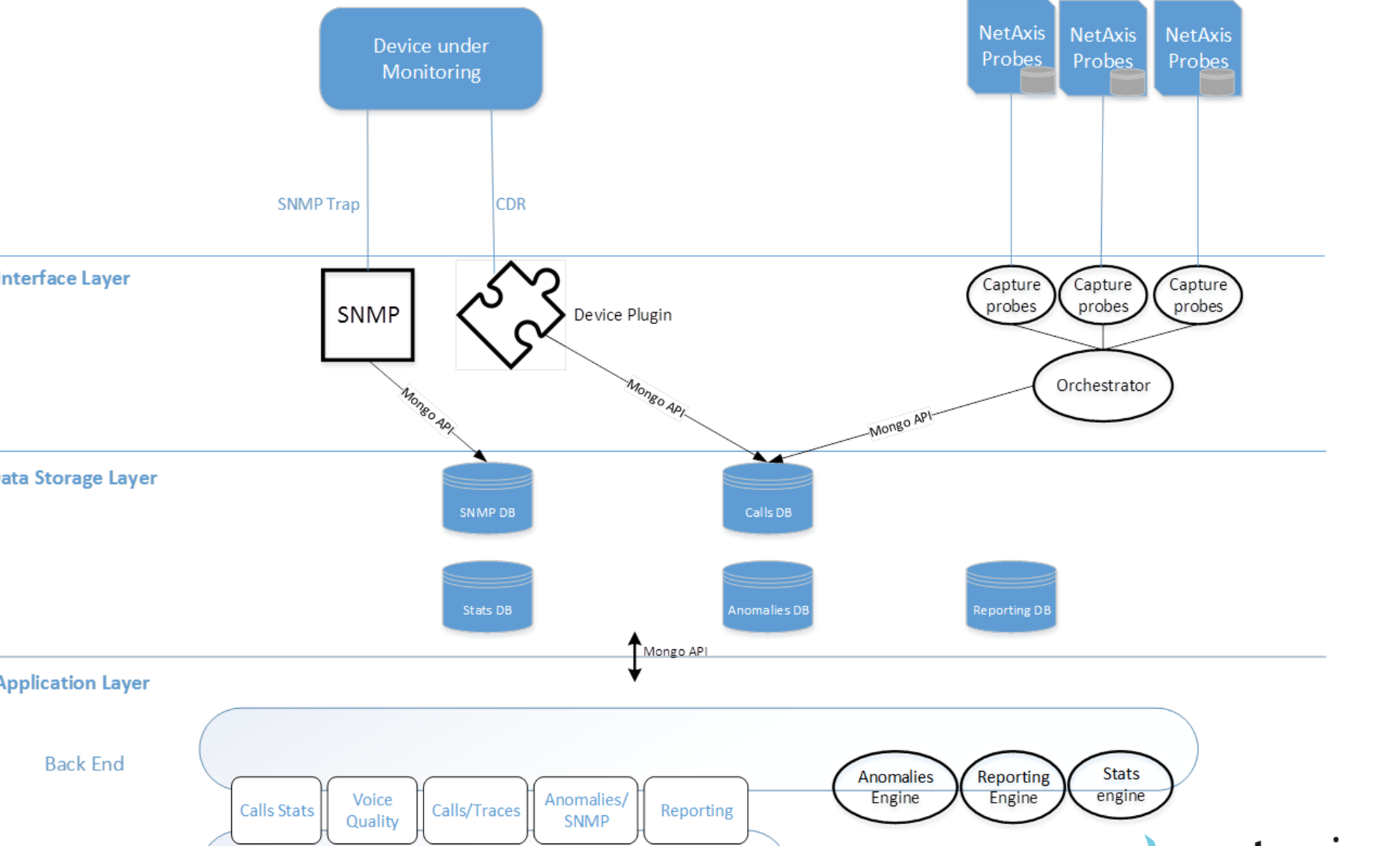
Feeling funky with my headlines today
gnTel choose Oracle Netaxis. I like this. I’ve replicated the press release here which is something I don’t normally do as I normally only do original stuff and I used not to want Google to penalise me in SEO rankings for plagiarising. However I’m not all that bothered about that kind of thang anymore so I don’t care if they do.
The bit I wanted to highlight was where it says “gnTel also chose NetAxis Solutions, an Oracle professional services partner, with deep technology competencies and experience, to design and implement their new service infrastructure.”
This is why me and Netaxis got together. Netaxis are a bunch of engineers with seriously good engineering capabilities. OK the press release is Oracle big company PR speak blurb but that’s by the by really. Oracle happen to be Netaxis’ biggest vendor partner as well so it is good that we are able to jointly shout about some good news like this.
2017 is a really busy year for us and it looks set to continue. The PR refers to NFV and cloud. This is where the action is all moving to. All our own software products, and there are many, are available to run in Virtual Environments. The telco world, especially that of big telcos, is not quick to move into new technology. They are wary, fearful. It’s why new smaller companies can win business from them. However the big telcos are now looking at moving into new fluffy white areas and I think we are well placed to have a bit of the action.
If you are a telco, however large or small we have something for you. If you are interested in Hosted VoIP platform integration – Session Border Controllers – Provisioning and Self Care – API Orchestration & Service Creation – Fixed Mobile Convergence – Network Monitoring and Call Tracing – SIP Call Simulator – Session Routing Engine – VoIP Fraud Management – Video Communications & Unified Messaging (lifted from my email signature) get in touch.
Ciao amigos. Press Release below.
REDWOOD SHORES, Calif., June 28, 2017 /PRNewswire/ — gnTel, a fast growing cloud-based telecom service provider to small and medium sized businesses in the Netherlands, has selected Oracle Communications technology to better scale their operations and lay the groundwork for the evolution of their network to NFV. Replacing their existing solution, gnTel will use Oracle Communications Session Border Controller (OCSBC) running on Acme Packet 4600 purpose-built hardware platforms to immediately create a new scalable access and peering infrastructure for their customers. This solution will allow gnTel to not only jumpstart their services but because of the close interworking between physical and virtualized OCSBC instances, and a flexible licensing scheme, also preserve this investment while they migrate to NFV.
Oracle Communications Session Border Controller is one of the industry’s leading border control solution that operates with most major IP-PBX, unified communications, and application server providers – reducing risks associated with commercial production level installations. Available on both purpose-built physical and commercial-off-the-shelf virtualized platforms, and coupled with a perpetual network-wide licensing scheme, OCSBC provides maximum flexibility to operators.
gnTel also chose NetAxis Solutions, an Oracle professional services partner, with deep technology competencies and experience, to design and implement their new service infrastructure.
“At gnTel, we recognize the fast pace of technology evolution in the telecom industry. We wanted to invest in a proven solution from a company that brings together expertise in cloud, virtualization, IT, and telecommunications,” said Onno Speekenbrink, gnTel. “Oracle’s solution and NetAxis Solution’s implementation will position us well for future growth.”
“Oracle’s cloud-ready session delivery solutions coupled with their extensive interoperability with third-party equipment and with our network monitoring software makes it simple for us to size, configure, deploy, and maintain the complex multi-vendor solution that gnTel requested,” said Bart van de Kar, NetAxis. “This project will further cement our expertise and relationship with Oracle.”
“In today’s marketplace, operators are looking for long-term, cost-effective and verified solutions that can improve their agility, streamline operations and accelerate time to market,” said Doug Suriano, senior vice president and general manager, Oracle Communications. “Oracle Communications SBC provides CSPs, such as gnTel, the unconstrained flexibility that supports their efforts now and in the future.”
To learn more about Oracle Communications solutions, please connect on Twitter @OracleComms and at www.youtube.com/user/OracleCommunications, or visit oracle.com/communications.
To learn more about NetAxis Solutions, please visit http://www.netaxis.be/.
For further information about gnTel please visit http://www.gntel.nl/en.
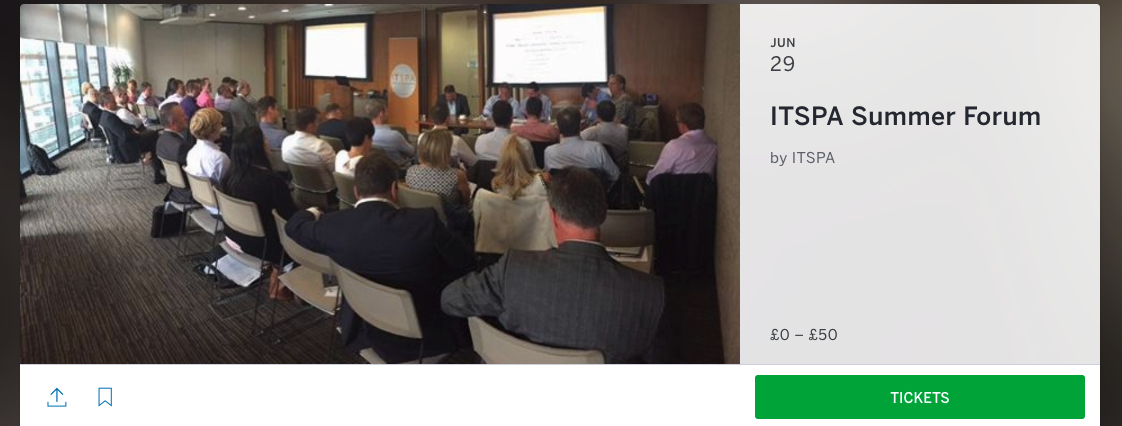
Jeff Pulver – the hottest ticket in town
As of this morning there are seven places left for the ITSPA Summer Forum (sponsored by Netaxis Solutions – that fine telecommunications infrastructure company). The Summer Forum is one of the highlights of the ITSPA calendar and we can expect a pretty packed house.
This is especially true this year as our guest keynote speaker is my friend Jeff Pulver who has very kindly agreed to fly over from the good old US of A to talk to us about his MoNage conference. Monage is all about AI, Chatbots and the internet of things. If you are clueless about this you might want to think about coming along. As I said we have seven places left, officially, although I suspect that if more wanted to come we would make room for them.
After all it’s not often you get the chance to hear Jeff speak. For those of you who weren’t around in the early days of SIP/VoIP Jeff became famous as a VoIP Pioneer with his Voice on the Net (VON) conferences. Jeff also founded the world’s first global ITSP, Free World Dialup, and was the founder of the company we all now know as Vonage. He has been around.
If you are in London and want to come along just register here – it’s free – just use the members’ registration.
Oh and there is an evening meal which is fully booked but at which the dress code is Hawaiian shirt. So if you see some of us colourfully dressed you will know why.
Btw if you are an ITSP and not already a member you should seriously consider joining ITSPA. Apart from fantastic networking events that give you the opportunity to mingle with others in the industry they have a whole host of benefits – check it out here.
Ciao amigos
Tref
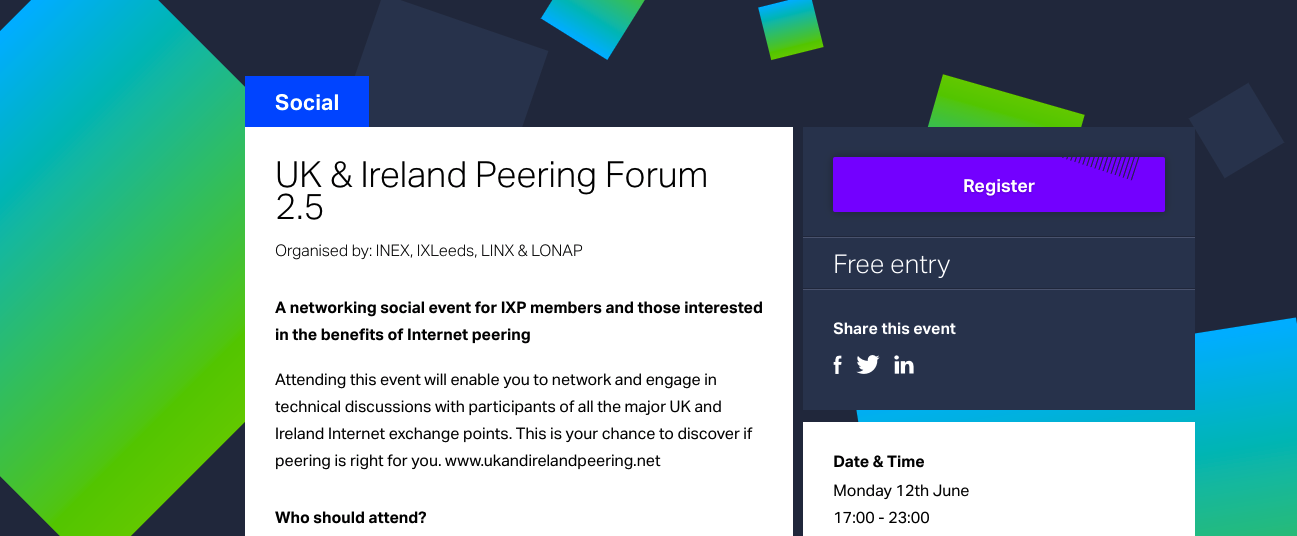
Informal social event for Network Engineers and Peering coordinators during London Technology Week – UK & I PF Social
Once again LONAP is joining forces with the other mutual IXPs in the UK and Ireland to promote Peering and facilitate the exchange of ideas in an informal atmosphere. Attending this event will enable you to network and engage in technical discussions with participants of all the major UK and Ireland Internet exchange points.
This event is specifically for Network Engineers, Peering coordinators and anyone who has organisational responsibility for arranging settlement free interconnection across one of the organising IXs.
This informal Social event is being held in London during The London Technology Week on the evening of the 12th June, address and registration link below.
Please do register early as places are limited.
https://londontechweek.com/event/uk-ireland-peering-forum-2-5-social
I look forward to seeing you on the 12th June.
PS I’ve had lunch a the the Fellow, the venue for this UK & Ireland Peering Forum Social. It is very convivial and we are guaranteed to have a pleasant and useful networking evening. The pub is on York Road down the side of Kings Cross Station.
Loads of other peering posts on this blog. LONAP btw is a ‘not for profit’ Layer 2 Internet Exchange Point (IXP) based in London. Our data-centres host a network of interconnected switches providing free-flowing peering to help minimise interconnection costs. We provide exclusive connectivity between members, who are effectively LONAP stakeholders. This ensures that LONAP members enjoy excellent value and maximum benefits.
Traffic exchanged between LONAP members, reduces volumes sent through upstream providers, reduces IP transit cost and bandwidth usage. Our membership includes ISPs, network operators and content providers with their own data networks. We provide regular opportunities for members to network and meet new suppliers, and support operators in growing their portfolio and reselling LONAP connectivity to networks outside of London.
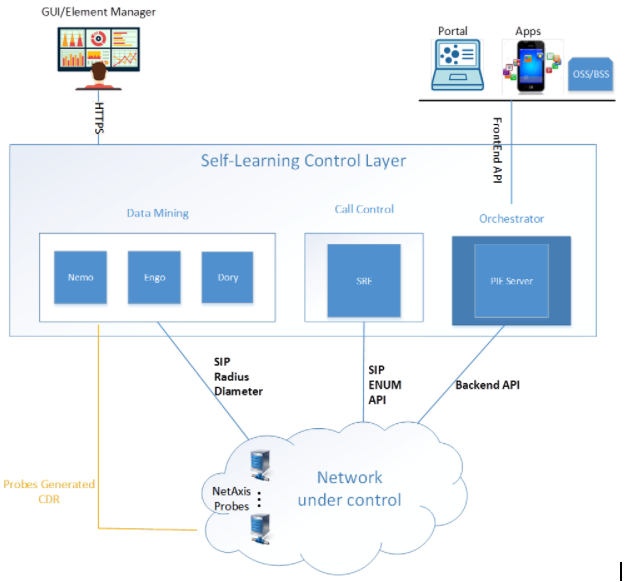
Carrier grade architecture for Session Routing Engines
It’s a fact that many ITSPs, certainly in the UK where there is a proliferation of them, do not need a call routing engine. Their (mostly) least cost routing needs are covered by their existing softswitch or by the Session Border Controllers they stick in front if it. As you get bigger however you do get to want more sophistication in a Session Routing Engine.
For example if you want to add more logic to the routing decision. I’ve already written about routing based on MOS scores but there are a whole load of other scenarios where routing decisions may be influenced by external factors. For example in scenarios where users are switching between persona and want different voicemail policies to be applied between personal and business calls.
The Netaxis environment supports this type of scenario and our Session Routing Engine plays an important part in it.
SRE was built for Tier 1 and 2 operators who need sophisticated routing capabilities. As a relatively new product we have also been able to play in features that make a carrier’s life a lot easier.
SRE Routing Framework
The SRE routing framework guiding principles are flexibility and openness. The data model and routing logic let you have unlimited routing policies. Call handling is defined as a set of sequential actions – the SRE comes with a rich set of predefined actions that drive the creation of the routing logic. New actions can easily be added to build up fully customized routing logic.
In addition, SRE is natively designed to query third party elements. This ranges from simple queries such as external database interrogation to much more complex scenarios like PBX interaction.
Service Logic Editor
The Service Logic Editor has extremely powerful and versatile functionality and is designed to let you create service logic in a few clicks. It allows the creation of any kind of route including those that are perhaps very specific or temporary/transient. Routes can be run in simulation/validation mode before being deployed to the operational network.
Carrier Grade & Scalable
In considering the architecture it has also been important to recognise that the end product has to be carrier grade. Resilience and capacity scalability is key.
An SRE based solution can be made of several Call Processing instances managed by a centralized Element Manager. The multi-instance approach offers wide deployment possibilities and huge scalability. Load balancers can be added to complete the picture. Call Processing is fully redundant working in High Availability mode.
Long experience has also told us that things can go wrong when rolling out network upgrades, even if you have tested it to the umpteenth degree. Bearing this in mind the SRE has a really cute data versioning feature. The SRE always keeps 2 set of configuration settings that can be toggled with a clock of the metaphorical button. Reversion to a stable release in the event of a problem during an upgrade is easy.
Who could ask for more? 🙂
If you do have any questions or would be interested in finding out more about our Session Routing Engine feel free to let me have your name and work email in the form below and I’d drop you some info. I won’t spam you but I need to know I’m dealing with serious people so no generic gmail type addresses please.
Netaxis is a competence centre for telecoms and now operates in the UK 🙂
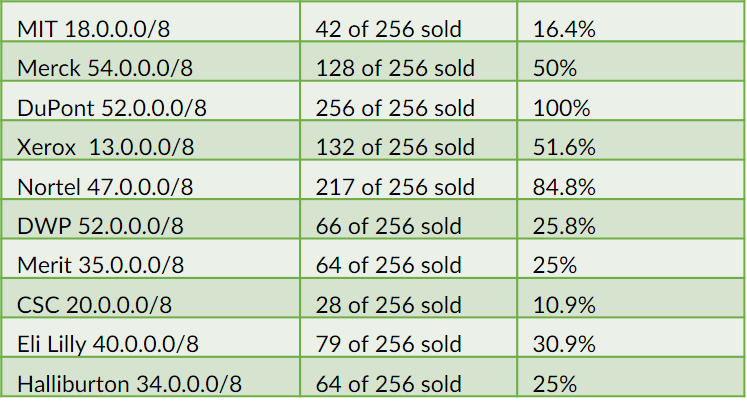
Guest post on IPv4 Address market by Sandra Brown
 Some interesting insights into the IPv4 address market by Sandra Brown who has been working this space for a number of years now. Read on.
Some interesting insights into the IPv4 address market by Sandra Brown who has been working this space for a number of years now. Read on.
In 2011, as Nortel’s Director of Engineering I started the orchestration of the sale of Nortel’s 47.0.0.0/8. Over time this undertaking has resulted in the sale of approximately 85% of the /8. Something that has been discussed in the ensuing six years, is how many other “organization” or “company” owned /8s might ultimately be sold. IPv4 Market Group has examined the before and after records in the Regional Internet Registry (RIR) databases, in addition to the RIR transfer logs, to see how many of these /8s have moved. All data being analyzed is publicly available.
As shown in Figure 1 below, there are 26 /8s that fall into the category of “organization” held. In this inventory, we ignore /8 blocks held by the US Defense Organizations, because there is no indication that the US Government has any intention of moving them in the future. We do include the UK Government’s two /8s, as we have seen past movement by the Department of Work and Pensions. We also include the US Post Office, as it seems likely this organization might desire a few million extra dollars at some point.
Figure 1: List of 26 /8s – organization or company owned
We are seeing that 10 out of 26 entities have “sold” a portion of their company held /8. These entities are shown in Figure 2 below. As of May 9 2017, 1076 /16s have been sold from the aforementioned /8s. This implies that approximately 16.2% of the 26 entity held /8s have been transferred.
Figure 2
Some of the transfers from these ranges, including other large transfers not from a /8, are shown in Figure 3 below.
Figure 3
There are notable points to be made:
- We know that approximately 16.2% of the 26 /8s have been transferred. This means that organizations are interested in monetization and that the trend should continue as prices rise.
- Most of the transfers from the /8s have been large transfers of /13 to /10. Big block holders are not selling their /8s one /16 at a time! (this is leading to a shortage in the /16 market)
- Can we predict how many of these /8s might still transfer? Those entities that have already sold some of their /8 range will probably continue to sell more over time. While 42% of the 10 /8s have already been sold, perhaps another 40% will move in the next five years, totaling 1024 /16s moved from these entities.
- What about the 16 /8 blocks from entities that have not yet sold a /16? We can speculate that some companies will never sell because they don’t need the money, and having the IPs is more of a strategic advantage than selling them. Or, they might not sell because even though the IPs may be sparsely used, it would take more work than they are prepared to undertake to free the blocks for sale. These could be the reasons why Apple, HP, and IBM never sell. However, other /8s may be available. We can scan the list and predict that at least six of these /8s will be partially sold in the near future. If they sell half of their holdings, it would total another 768 /16s in the IPv4 transfer market.
- Who is buying the large blocks? There are 14 different buyers shown in Figure 3 Two entities in particular, Microsoft and Amazon, have received large portions of the transferred IPs. Microsoft has bought from 4 of the 10 sellers (CSC, DuPont, Xerox, DWP) and Amazon from 5 of the 10 (Merit, MIT, Xerox, DuPont, Merck).
- Is there a market for the large blocks of the future? IPv6 is still years away from a critical mass and we continue to hear about the costs and headaches of its implementation. As long as IPv4 is the “best” and cheapest solution, we will continue to see a market. The question then becomes, “what is the expected price for these large blocks?” We are already seeing $13 to $15 per IP for large holdings, most likely because they are so rare. Is there a price point where buyers walk away? Yes, of course, as we are seeing some companies refuse to pay the market price already. Microsoft and Amazon have deep pockets, so it would be speculation to put a number on their maximum.
This analysis of the 26 single-owner /8s has shown that these large blocks are being transferred in large sub-allocations, and the /8s are not filling the /16 market. Ten of the 26 have already done some selling, and we expect this trend to continue, to more than double the large block sales made so far. The IPv4 Market has some legs still!
Sandra Brown, IPv4 Market Group

Session Routing Engine is us
Had a really good working lunch last week with special guest Laurent Debacker. Laurent runs fixed and mobile network operations for Belgian telco Voo and provided us with a very interesting talk about their implementation of the Netaxis Session Routing Engine.
Some of you might think there is nothing much to say about routing engines. After all, you just set one up, point traffic in the desired direction and your Uncle’s name is Bob. Maybe you employ least cost routing and periodically upload new rate cards. That’s about it when it comes to routing engines. Isn’t it?
Well maybe it is and maybe it isn’t. Classically routing engines are unwieldy beasts and offer little incentive for people to do anything imaginative with them. However the telco world is rapidly evolving and your routing implementation needs to evolve with it.
Here I offer you one scenario:
Least cost routing is important because if you don’t watch your supplier rate cards you can quickly rack up losses on any given routes. However if you don’t watch the quality of your chosen routes you can quickly lose customers, or at least build up sufficient levels of disatisfaction that they start to bombard your helpdesk.
If you had a means of actively monitoring the quality of lines to specific destinations you could avoid this. Happy customers mean higher spending customers.
Netaxis have a suit of products that are built around our Session Routing Engine. The combined system includes the Nemo Network Monitoring tool which provides MOS scores for specific calls and the Dory call simulator. When combined with the SRE you can produce data on the quality of specific connectivity partners and make routing changes in real time based on this quality. It is also possible to get network alerts telling you that specific destinations have had changes to the carrier. The new carrier may not be the lowest cost but could serve as an interim solution whilst you address the quality issue with the original.
If you want to know more about how we can do this just get in touch.

RIPE74 report from Budapest
Sat in the RIPE74 meeting having arrived at tea time last night. Every time I come to these meetings I am reminded at how good these events are. It’s not just the content. It’s the opportunity to meet folk relevant to your business that you wouldn’t normally see on a day to day basis. Here they are all in one spot and you spend your time catching up with them and their business.
These meetings – RIPE and their ilk – are how LONAP do our marketing. We are a bunch of engineers rather than sales types. We chat with engineers about engineering at engineering events. LONAP is an Internet Exchange Point for engineers.
RIPE74 happens to be in Budapest. I’m a Budapest virgin. It looks an impressive place. At first glance. The featured image is the view from my room. I’ve not really had a chance to get out of the hotel yet although Richard Irving and I did get out for a quick bite around the corner last night. The opportunity will come. RIPE74 finishes Friday and I don’t fly home until Saturday lunchtime.
I’ll be sticking more pics from Budapest up on Facebook as and when I get the chance to take some. Budapest, I found out from the taxi driver en route from the airport is divided into two halves separated by the river Danube, Buda is the historic area seen in the pic and pest is the newer less interesting bit. Apparently. Famous for it’s outdoor spas. Will have to see if we get a chance to go to one. The days are pretty busy.
If you want to chat about peering at LONAP just tap one of us on the shoulder. We are proudly wearing our black LONAP polo shirts. Loads more peering posts on this blog by the way. Check ’em out.
SME cybersecurity – should they care?
Small retailers and businesses aren’t doing enough on cybersecurity. This, at least, is what emerges from a survey published recently from domain provider 123 Reg, who canvassed 13,000 online retailers and discovered that 10% of them aren’t taking any steps whatsoever to protect their customers’ personal data.
This is a worrying figure, and while 10% isn’t perhaps a massive percentage on its own, the survey also found that 50% of e-commerce owners admit to not being prepared for an attack and to not having a recovery plan in the event of a breach.
While such findings are already disconcerting enough in simple terms of cyber and data security, they’re also troubling for another reason, which is that they reveal how smaller online retailers are jeopardising their businesses and their trustworthiness by neglecting the security of their websites and platforms.
This isn’t something suggested only by 123 Reg’s recent survey, but also by other research. For example, in June 2016, Barclaycard conducted their own survey on SME cybersecurity, learning that only 20% of small and medium enterprises held up online security as a top business priority. This was despite the fact that 48% had knowingly been the victim of a cyberattack and the fact that 54% were concerned about hacking.
And this stands in marked contrast to larger enterprises. Larger businesses take cybersecurity more seriously and invest more in it, with the latest Thales Data Threat Report revealing that 73% of large international corporations will be increasing their security spending this year. Similarly, the report also shows that 88% are highly concerned about data security, while a similar Zurich Insurance survey of SMEs from last year found that only 8% rank cybercrime as the top risk to their business.
Of course, larger companies are targeted in more high profile ways than their smaller counterparts, yet what should be unsettling for SMEs is that attacks against them are on the increase. In 2016, smaller businesses were hit by some 230,000 attacks, while the percentage of breaches targeting SMEs grew from 18% in 2011 to 43% in 2015.
One way of interpreting such growth is that, as cybercrime grows and becomes almost ‘professionalised’, cybercriminals are increasingly realising that smaller retailers are a soft target. And as the surveys mentioned above indicate, this is because SMEs aren’t devoting enough attention to the security of their websites, servers, networks and platforms.
As a result of this inattention, 74% of SMEs suffered an information security breach in 2015, according to Government figures. And this proportion is likely to grow, especially in light of how an August 2016 survey from Close Brothers revealed that 63% of SMEs have actually decided not to invest in improved online security in light of the EU’s General Data Protection Regulation.
Somewhat luckily, SMEs lack the kind of visibility that would result in breaches being widely reported in the media. However, if attacks against them do indeed continue increasing, and if the public become increasingly aware of these attacks, then trust in smaller online businesses and retailers will be damaged.
And as the notorious TalkTalk hack from October 2015 plainly revealed, a violation of customer data wouldn’t result only in a loss of trust, but also in a loss of customers. And for smaller retailers and businesses eager to hold onto as many of their customers as possible, such losses would be very damaging.
It would result in small and independent retailers losing even more custom to giant online outlets such as Amazon and eBay, in the process strengthening even further the stranglehold such larger companies have on digital spending and shopping. At the moment, a whopping 55% of all online product searches are made on Amazon (at least in the US), and this share will only increase if SMEs continue being too inactive on cybersecurity.
This is why, even with smaller budgets, SMEs must take greater action to strengthen their data and cyber security. More of them need to adopt such measures as multifactor authentication for important company accounts, drawing up contingency plans for cyberattacks, conducting regular tests and assessments of the strength of their cybersecurity, and tightening physical and online access to sources of sensitive information.
By taking such steps, and perhaps by going so far as to employ dedicated information security officers where possible, SMEs will be in a much better position to guard themselves against the rising tide of cybercrime.
Yet more generally, they’ll be in a much better position to guard their businesses, their reputations, and their relationships with their customers. And given that they make up 99% [PDF] of all UK businesses, they’ll also be better placed to protect the British economy at a time when it needs more than ever to grow.
This is a guest post by Simon Chandler, News Editor of Choose, a consumer price comparison and information site covering broadband and personal finance services. Simon wrote the post a few weeks ago and I’ve been a delinquent in sticking it up. I don’t typically take guest posts from sites who are doing it for their own SEO benefit but in fairness to Choose they supply good quality copy and I wish them well with it.

Taking Control of Your Network – The Self Learning Control Layer
The development and implementation of telecommunications networks and services has traditionally been a long drawn out affair. Even the smallest project might have an 18 month gestation period. Major network roll outs much longer. The advent of API driven environments provides us with the opportunity to change all this and here I discuss the concept of the Self Learning Control Layer (SLCL). The SLCL is an intelligent overlays to VoIP networks driving efficiency, reducing costs and making it easier to add new products and services.
Self Learning Control Layer Building Blocks
An SLCL has three building blocks:
- Data Mining,
- Call Control &
- Orchestration.
Data mining is used to monitor activity and health in a network. Call Control is used to effect change to traffic routing based on information provided by the Data Mining and Orchestration. Orchestration makes provisioning decisions based on predefined policy, inputs from both the network and from end users.
The types of learning the network might make include:
- addition of capacity to or traffic rerouting away from congested areas – eg based on MOS scores
- automatic shut off of calls considered to be fraudulent traffic
- Routing policies altered by a change in an user’s status (eg from “business” mode to “personal”) or the provisioning of additional capacity based on the addition of new users to a network.
The SLCL is designed to make your network easier and cheaper to operate to make your customers happier. Being API based it also makes it easy to integrate with your existing network infrastructure. The SLCL is a concept developed by Netaxis who provide all the building blocks you need to implement it.
I’ve already discussed elements of the SLCL in my posts and workshops on VoIP Network Monitoring, fraud detection and call simulation.
Session Routing Engines
My next focus is going to be on Session Routing Engines. The SRE is a key component of the SLCL and is the heart of the Call Control function.
Essential features include:
- APIs to standard network elements such as softswitches, Session Border Controllers, VoLTE and IMS and indeed other existing Core Routing Engines
- SIP & ENUM
- Be flexible and easy to implement
The SRE is the subject matter of my next working lunch which is in London on Wednesday 3rd May. At this event we have a special guest, Laurent Debacker of Belgian telco Voo who is going to talk us through their own implementation of the SRE and act as a catalyst for a general discussion around this subject.
You can check out details of the event here. It’s free to come to but you have to be a VOIP network geek for it to be worthwhile for all attendees – we want an active discussion on this subject and places are limited.
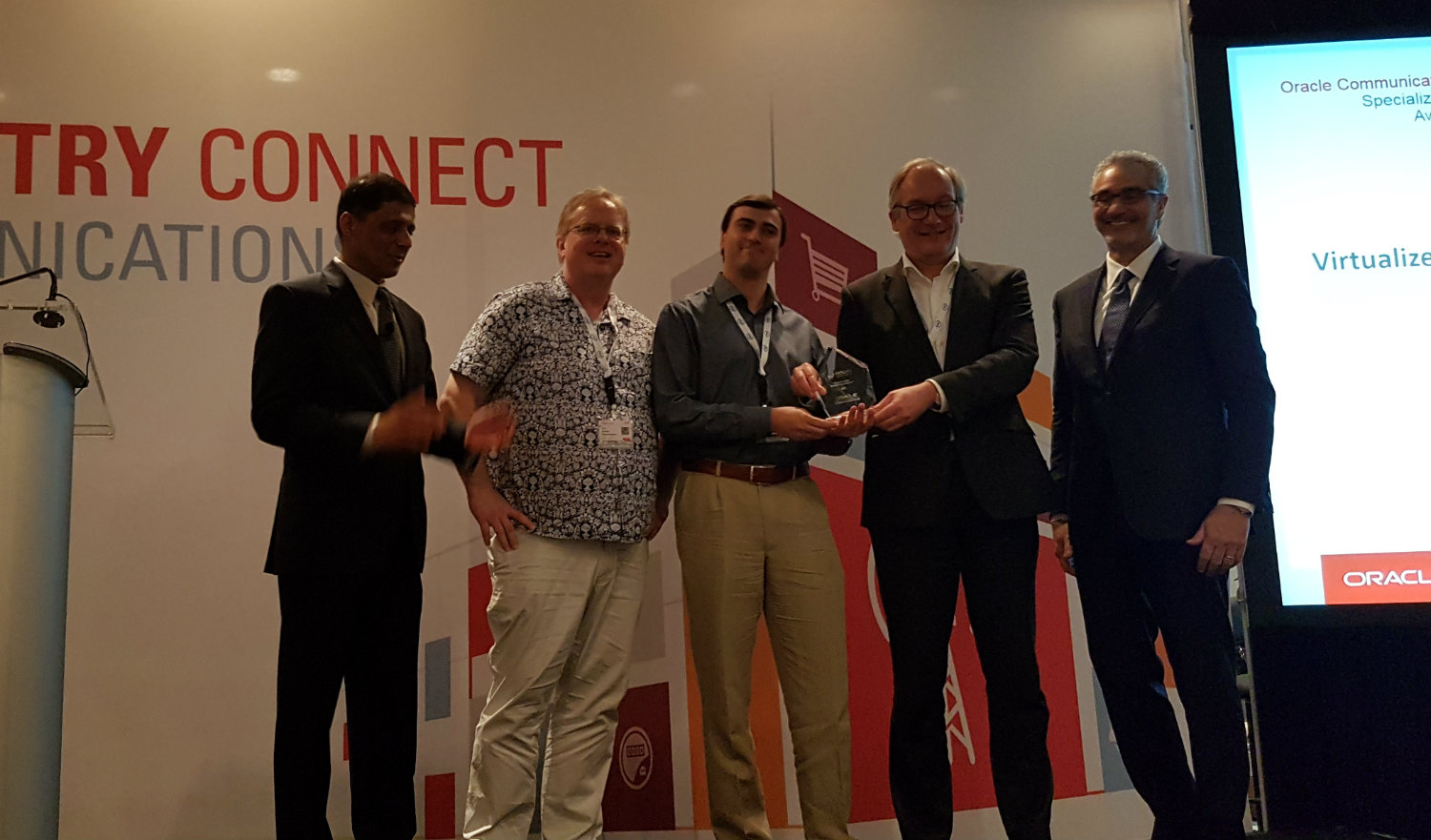
Netaxis win Prestigious Oracle Award
Totally thrilled to tell you that last week, at the Oracle Industry Connect event in sunny Orlando Florida, Netaxis Solutions were presented with a prestigious Oracle Award for services to the industry. Or something like that 🙂
Oracle are important business partners for Netaxis. We use their Session Border Controllers in many customer solutions. The business was originally built around these products. We have moved on to some extent in that much of our business these days hinges around products we have developed ourselves – network monitoring, provisioning, anti fraud etc etc but Oracle are still important.
So it’s nice to have an award you can stick in the company reception, or on the internet more like. In fact blog posts like this are just the point of these awards. Something you can write about, boast about.
It isn’t without justification. Netaxis, a relatively small Belgian company but one with expansion plans (enter moi stage left), are going places. We have an unique skillset in the telecoms industry, especially for a company our size (30ish engineers). There ain’t many companies around who do the Systems Integration but also can develop the missing bits of the systems being integrated. That’s really how our product suite has been built up – customers have asked for features and we developed them. Quickly.
As I write this I’m sat in our company Annual Review (still jet lagged). We have 54 customers in 7 countries. These are all Telco customers. I’m quite impressed, considering the company is only 6 years old. It shows there is something there. Something Netaxis has that is interesting.
What is really interesting, and this comes from the fact that we deal with so many Tier 1 telcos, is the fact that there is a lot of mobile network development going on at the moment that is based on global standards: 3GPP and IMS/LTE. These standards are very constraining. They have to be in order to make the network work. This in turn makes it difficult for operators to differentiate themselves. Although these standards expose APIs few companies using these APIs.
That’s where Netaxis come in. Our own products make it easy for network operators to differentiate themselves. We are API based. This also makes it easier for operators to design cheaper to run, lower cost networks.
It’s an exciting to be involved. In case you didn’t spot it I have a joint venture with Netaxis in the UK. I am going to unashamedly discussing Netaxis and their capabilities on this blog. Not really any different to what I did with Timico. Only interesting stuff of course. No boring stuff.
Anyway we won a Prestigious Oracle Award. In Orlando, Florida. Good eh? The pic is of us three Netaxis boys, me, Alessandro and Bart, flanked by Oracle high ups. That’s a Welsh-Irish/Italian/Dutchman working for a Belgian company.
Ciao amigos…
PS this pic is the only one in which you will see me wearing long trousers in Florida.
PPS was sad to hear from the Uber driver to the airport that tourism is the main industry of Florida. This is obvious. The sad thing is that it used to be orange growing. A far simpler existence, if less lucrative.

Report from Mobile World Congress 2017
It’s been a busy few weeks with some highlights, not the least of which being our exit from Timico shareholding. It brings to an end what was a great journey. We started Timico in April 2004. I kind of retired after ten years or so but remained a shareholder. It now feels as if the project has finally come to an end. Obviously Timico continue its journey but whilst I retain a fondness for the company it feels good to be able to move on.
Last week I was in Barcelona for Mobile World Congress 2017 supporting Netaxis. I’ve always been a bit sceptical about the business case for exhibitors at these big huge trade shows. They are so big you wonder how anyone can find anything. My justification for going was to meet partners. All the big infrastructure players (Oracle, Sonus, Genband, Broadsoft et al) have a presence there so it is a useful spot to arrange to meet all of these folks, even though it can be a 20 minute walk between meetings!
However I did come across a real example of the customer acquisition process. I was sat on my own at the Netaxis booth, just resting my feet really, when someone wandered by and stopped in front of me to read our spiel. I looked at him, he looked at me. I sat there passively. He came up to me and we started to chat. I realised I was having to move into elevator pitch mode which I did reasonably well I think.
We were just approaching the top floor in the elevator when Jean Seb came back to the booth. Jean Seb is the designer of our Nemo VoIP Network Monitoring tool. I casually handed the pitch over to Jean Seb and joined in where relevant. The prospect, a US based telco, was suitably impressed and we now have a lead to follow up. Don’t you just love it when it goes well like that?:)
The easiest way to do MWC is to just find a comfy seat and sit there. Everyone you know will swing by at sometime. I was sitting on a sofa at the Genband stand chatting to old SIP Forum pal Professor Alan Johnston, one of the original authors of the SIP protocol when a steady stream of people we knew walked by. Why have a booth when you can borrow someone else’s:).
I also took the opportunity to catch up over breakfast with Jeff Pulver who I hadn’t seen for years but who was in Barca to speak at a different gig.
The best bit about MWC are the evenings. These make the trip that much more exhausting but are the fun bits. If I tell you that my normal bedtime is 10pm but that the earliest I got to bed in Barcelona was 1.30am it will help you to understand. On my last night we ended up at “Swedish Beers” with Curtis Peterson of RingCentral and Adam Beaumont for AQL. Adam has been a long term sponsor of the event which as far as I can see has nothing to do with Sweden or Swedish Beers. The beer did flow voluminously and a good time was had by all. I later found out from Facebook that Alan Johnston was there at the same time. It was so packed we didn’t see each other.
So that’s it. Name dropping over. We are now well and truly into March and the third month of being for Netaxis Solutions UK. Watch this space…

VoIP Network Monitoring workshop learnings
Terrific VoIP Network Monitoring workshop on Tuesday. Ended up with around 25 engineers in the room. Who would have thought that 3 hours would whizz by when talking about this subject? Thanks to all who came especially Raph from Netaxis, Ade and Ben from Zen Internet and Florian from Oracle. They all did a sterling performance with their respective demos.
These small workshops are great. You always learn something new and there are a lot of nuances to this subject. I found a particularly useful feature on the Netaxis Nemo tool (OK I am with Netaxis but it is an useful feature:) ) Nemo can correlate CDR data with the traces and logs of the call being made. It is therefore very easy to track down a recording that may have been made using a network probe based on the number of the calling party. Handy in situations such as call centres where someone may ring back and complain that what they got was not what they asked for previously.
I think the biggest issue this industry is going to have with VoIP Network Monitoring is in the move to the cloud. Currently for anything more than a low number of sessions it isn’t particularly practical to monitor RTP traffic in the cloud. Data throughputs mean you need physical network TAPs to mirror the traffic and the cloud ain’t physical is it. Picture the scene. A massive AWS datacentre with rows and rows of identical cabinets but with one TAP sticking out like a sore thumb.
If all you want is signalling data you will probably be ok but most network managers want to be able to listen to real media when troubleshooting problems.
Afterwards we all trooped to Craft Beer on Mitre Street and then on to The Lahore Kebab House on Commercial Road. This curry house is a real find. Great food. No booze but you can bring your own from the off license next door. I especially recommend the chicken tikka and lamb chops. If you’re ordering onion bhaji that’s a meal in itself.
I digress. Get in touch if you want to know more about what we can offer in the way of VoIP Network Monitoring. Or anything else in the VoIP network game really 🙂
Next workshop is about Session Routing Engines on Wednesday 26th April. Exciting eh? Save the date. More deets to follow.
Thanks to Oracle and Netaxis for the food and drink afterwards 🙂

All about VoIP Network Monitoring
The UK VoIP industry is maturing. Networks are growing, subscriber numbers are increasing and the tools people used when they first started may no longer do the job.
Once upon a time it was just fine to use freeware. After all there is plenty of support out there. Usergroups willing and eager to help. On a best efforts basis obvs, or paid for even. Now you haven’t got the time to do all that stuff yourself nor all the learning that has to accompany it. There comes a time where the growing ITSP that once managed on a shoestring has to face reality and begin to look at turnkey vendor solutions that come with their own support and carrier strength operations.
Network monitoring is one such area. I’m finding a real interest in this subject in the UK. My VoIP Network Monitoring Workshop has been very well subscribed. Of course it helps that there is free beer and curry afterwards but to be honest that is by the by. The UK tech community is interested.
I wear a number of hats where VoIP Network Monitoring is concerned. Netaxis have our own product, NEMO, which has just undergone its third major release. Netaxis also act as a Systems Integrator and support a wide range of 3rd Party vendor tools. Included in this is Oracle’s OCOM integrates well with Oracle’s own Session Border Controller line as well as via external probes.
It’s only recently I’ve really dug into this whole subject. Obviously things do go wrong in any network and especially in VoIP network where there can be so many topologies involved. Also as your number of subscribers increases the more likely it is that you will encounter problems. Because voice is mission critical to a business these problems are going to make for uncomfortable times unless you have the right troubleshooting tools.
This means being able to drill down into into individual voice calls to see what is going on. What’s the voice quality (MOS Score) looking like? Is the problem only happening at particular times of the day? Why is that phone constantly re-registering? Is it a site wide problem? Are calls timing out after the same amount of time? Is it handset specific? Codec specific? Lots of variables to contend with.
When your network grows you also need to start thinking about how and where you deploy your VoIP Network monitoring tools. Network data needs collecting, storing and analyzing. How do you work out how much storage you need? What’s the profile of your customer base? How many simultaneous calls? What’s the average duration? Which calls do you want to record? All of them or just ones that you are trying to troubleshoot? How long do you want to store the RTAP data for.
All of a sudden you are into an engineering effort just to figure out what the specs of your probes are going to look like. Will you need much bandwidth between the probe and your network monitoring server. What TAP spec do you need? Traffic has to be mirrored somehow.
There’s a lot more to VoIP Network Monitoring that people sometimes realise. What’s more the scope of what is wanted out of a VoIP Network Monitoring tool has grown. Firstly it’s a natural source of data for call recording purposes other than mere troubleshooting. Regulatory requirements perhaps?
Then there’s fraud. If you are monitoring all your network traffic it seems to make sense to be able to analyze this traffic for patterns that suggest fraudulent activity. What steps do you take for fraud mitigation? Does your VoIP Network Monitoring tool also help you detect fraud?
I think I’ve gone on long enough. If you want to join the discussion on this subject just sign up for my VoIP Network Monitoring Workshop on 21st February. Don’t come along just for the beer and curry though. I’m after participation. Involvement. 🙂
Oh and if you want to talk to me directly about what we can do for you in respect of VoIP Network Monitoring just get in touch. Y’awl.

VoIP Network Monitoring Workshop update stuff
Quick trefor.net VoIP Network Monitoring Workshop update I have planned in town on Tuesday 21st February. The workshop is being held at Gamma’s offices near the Gherkin (St Mary Axe) with free beer and curry generously provided by Oracle and me, with my Netaxis Solutions UK hat on (blows on fingernails and polishes).
I’ve booked the pub and the curry house. Pub is The Craft Beer Co at St Mary Axe where we have the downstairs room for a couple of hours after the workshop. 5 – 7pm say. Check out their beer . Some seriously good stuff there.
Secondly I’ve booked Lahore Kebab House on Commercial Road. This is not only supposed to be one of London’s top Pakistani gaffs and can handle large groups but comes recommended by people I trust about this sort of thing.
If you are in the industry and can’t make the workshop but fancy coming for a beer then you are welcome to do so. Just let me know. only beer though. Curry is reserved for the hard core who sign up for the VoIP Network Monitoring Workshop.
Currently we have 24 people coming to the Workshop and have room for 30. More if you are late to the party but run a VoIP network and are really interested. Again let me know. At the moment I have 6 spaces left with 3 people who i know are coming but have yet to sign their names in the box.
I have now run a number of workshops at the Gamma offices in the City. They have great meeting facilities and are very happy to loan me the space. However I have had bounceback from one or two network operators who are Gamma competitors. I am happy to move the show around if you want to get in touch about using your space. Needs to be able to cope with at least 30 and up to 50 people with some coffee facilities (beer is also acceptable). In return you get some great exposure in the ITSP community. Let me know.
That’s my VoIP Network Monitoring Workshop update. If you want to come sign here.
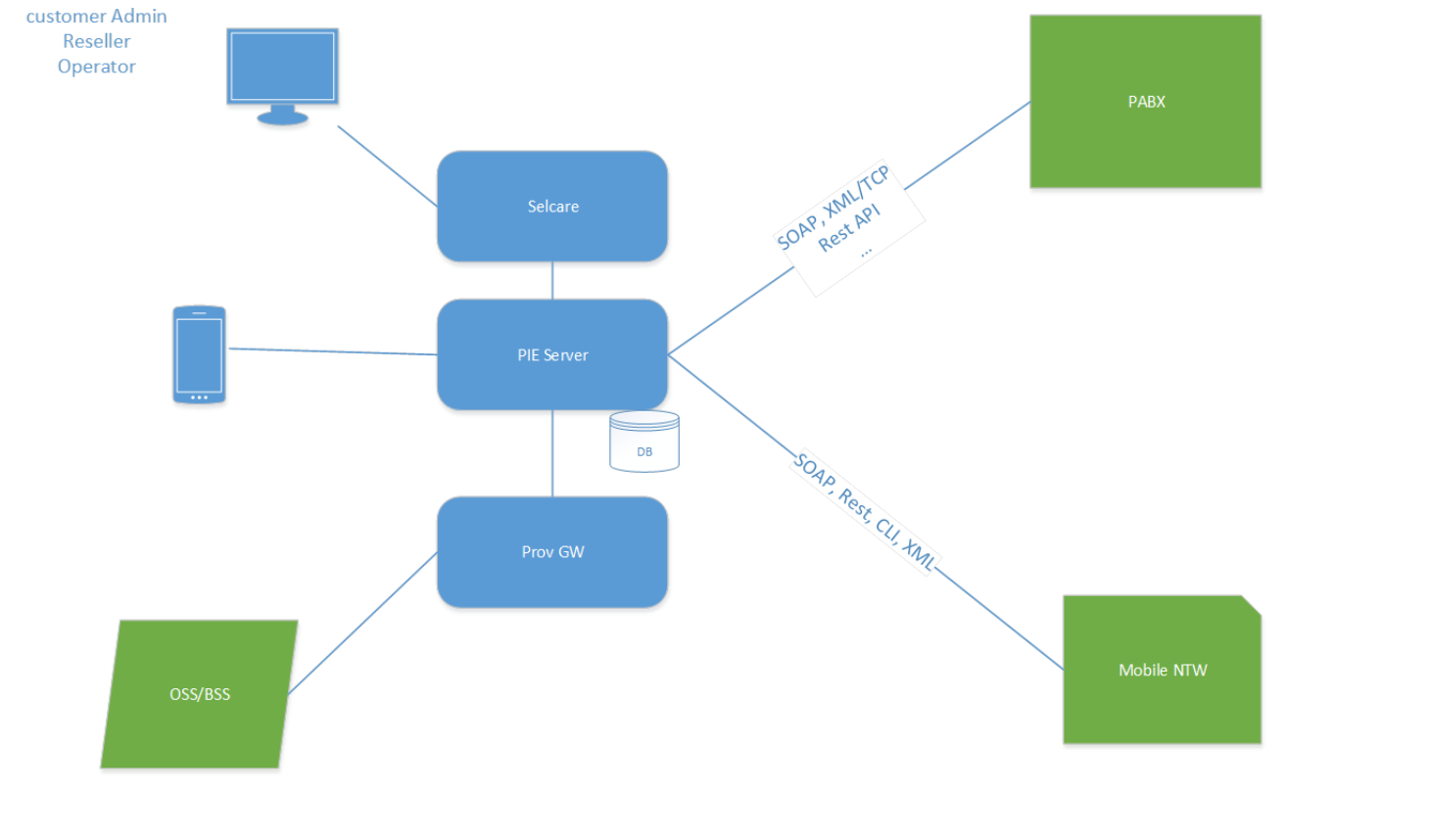
Showcasing Fixed Mobile Convergence Mobile World Congress 2017
Fixed Mobile Convergence Mobile World Congress. If you are thinking of going to Mobile World Congress in Barca next month let me know and we can hook up. I’ll be there with Netaxis where we will be showcasing a load of nifty stuff including our Fixed Mobile Convergence server PIE.
Netaxis Solutions provides innovative Fixed Mobile Convergence solutions for mobile network operators. Grow your fixed line business and make your mobile offering more sticky and vice versa. Our PIE server provides customer self care and provisioning, is a bridge between Fixed and Mobile networks and provides an interface to all mainstream hosted VoIP platforms.
This Fixed Mobile proposition is a very simple solution. Our PIE server acts as a gateway between the fixed and mobile worlds and lets ITSPs easily integrate their own platforms with your networks. You do need a mobile network or a relationship with one.
If you have a mobile network then this is a serious proposition especially if you are a fixed or mobile wholesaler. Attract new ITSP business partners/resellers by allowing them to offer their customers the ability to integrate mobile solutions with their own hosted service. Works with all the main Vendors: Broadsoft, Cisco, Skype For Business et al and we can easily adapt it to others.
Come and talk to us about it at Mobile World Congress 2017 in Barcelona between February 27th and March 2nd. You can find us on our stand 7G71 in Hall 7.
See live demos at the booth of products and services that will help you run your networks more efficiently.
- Nemo – Network Monitoring & Call Tracing
- PIE – SelfCare Provisioning & Fixed-Mobile Convergence
- Engo – Voice Fraud Management
- Dory – SIP Call Simulator
- SRE – Session Routing Engine
- Vivo – Video Communication & Unified Messaging Platform
Mobile World Congress is the world’s largest gathering of the mobile industry. I won’t be manning the stand specifically but I can arrange to meet you there and/or go for a beer. Just let me know. You can email me at [email protected] (I’m still working on this).

Netaxis Solutions UK
Thought I’d share some news with y’all. Last week we set up Netaxis Solutions UK, This is a joint venture between me and Netaxis in Belgium, a business I worked with last year on a consultative basis.
Quite exciting really. Netaxis are an engineering based company that partners with telecoms network operators.They are very successful in their space For me it’s a step back into the core of technology rather than the retail world of Timico, which is what took up the best part of the last decade or so.
I say telecoms operators but the game has changed massively since the word telecoms was first coined. It’s almost a redundant term but there isn’t one that has come along to replace it. At least not one that people readily identify with. The word communications provider is a little wishy washy and Internet Telephony Service Provider doesn’t tell the whole story.
The reality is that in providing services to end users (business or consumer) a network operator has to be able to grasp a huge range of technological capabilities. Some choose to specialise in Over The Top fields such as video conferencing or VoIP services. These might be quite big markets in their own right but such companies rely on partners to provide the network.
Operators of networks themselves can’t do everything. They too have to partner. Netaxis is such a partner. We began life as a systems integrator but gradually began to add our own technological capabilities and IP based on requests of the customers of our SI services. This has resulted in the development of a broad and still evolving set of capabilities that includes network monitoring, call simulation and VoIP network stress testing, anti-fraud software and services, routing engines, Fixed Mobile Convergence servers,provisioning servers, video capability and WebRTC function integration.
Add to this IMS core network design and development skills and you have a pretty powerful mix of capabilities that makes us well placed to help network operators in the UK move ahead in what can be bewildering waters.
Netaxis still offer a range of services and solutions from industry players such as Oracle, Genband, Broadsoft, Audiocodes et al but our pitch is that we are vendor independent and can work with anyone.
I’m not really a sales person but I plan to market Netaxis in the UK through some tried and tested methods. Customers need to see the value of working with technology partners. We aim to do this be expanding on the number of trefor.net workshops and seminars during the course of 2017 to include subjects that might not be particularly sexy but should be of interest to service providers and network operators in our game. Whilst at Timico I kept trefor.net independent – the same is going to apply here.
In the second half of 2016 I held a successful fraud workshop and a working lunch (finished at 6.15pm!) where we discussed VoIP call simulation techniques and uses. Look out for event announcements in the near future. Note that these are going to be trefor.net events. They may even have Netaxis competitors in attendance. I’m not in the game of trying to sell people things they don’t need or want. I want an easy life:). I am betting though that you will want something we have. I want people to come and say to me “Iike the look of that left handed server Tref” or “hmm wouldn’t mind trying out Netaxis’ call simulator” etc etc.
What I also want is to make it easy to do business with Netaxis. Push that door and I hope you will find it swings open. Time will tell but in the meantime wish me luck and feel free to ask me questions on life the universe and Netaxis Solutions UK. I trust 2017 is going to be a great year for us all.
PS I decided I was too young to stop working 🙂 What did it for me was two weeks I had set aside for jury service that was cancelled at the last minute. I had nothing in the diary and there is a limit to how many holidays you can go on. I needed motivation and with Netaxis Solutions UK I now have the motivation.
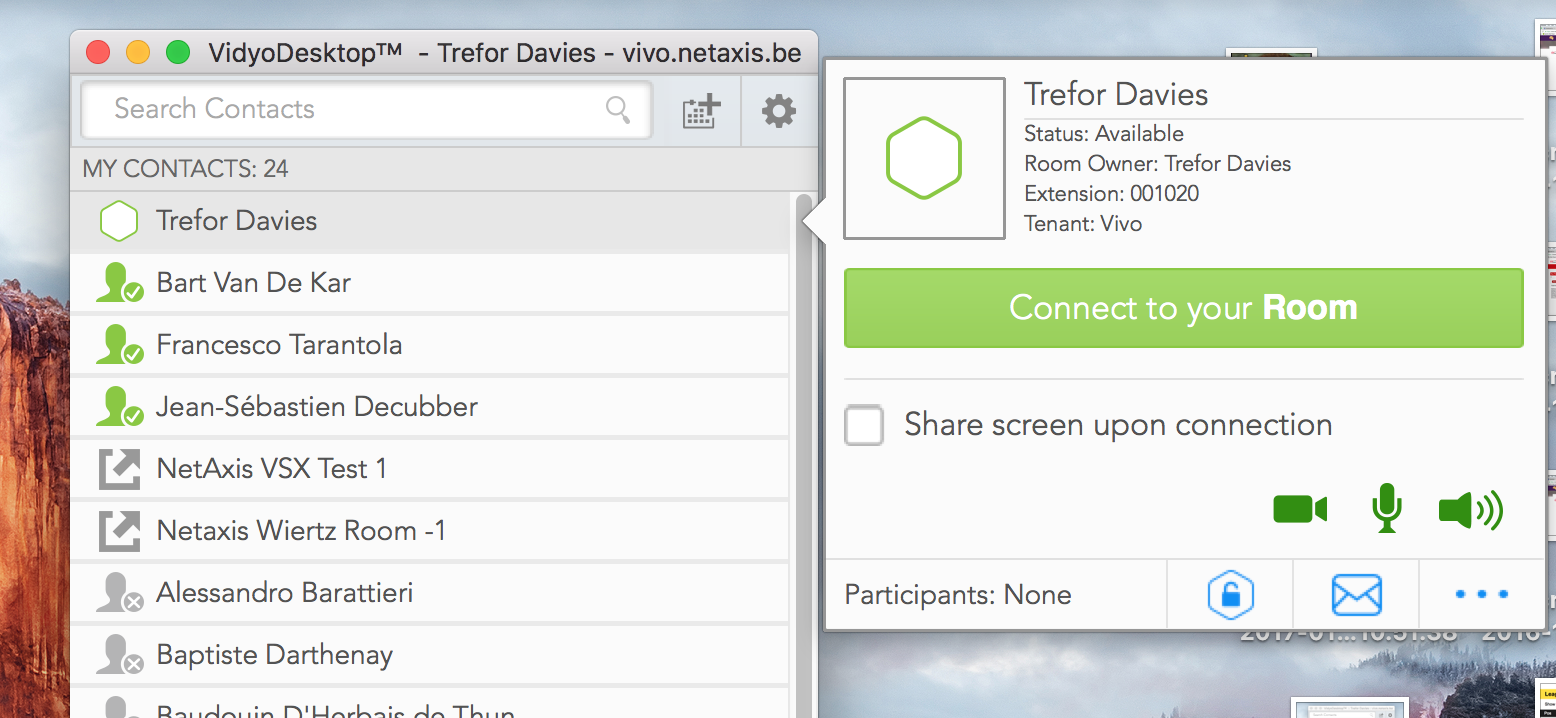
Vidyo video conferencing takes the strain out of taking the train
Interesting statistics for Netaxis’ internal usage of their Vidyo video conferencing solution in 2016. We had a cumulative total of 91,496 minutes of connections. That’s 2 months, 3 days, 12 hours and 56 minutes of connections. There were a total of 974 meetings connecting 2,000 people with an average of 2.05 persons per meeting at a duration of 45 minutes. Meetings under 15 minutes were not counted.
Those are quite chunky stats. Over the period concerned Netaxis had around 25 folk in the company and they operate a flexible working policy which means any one person can be working from home, at a customer site or in the office (or down the pub etc).
I was quite surprised when I saw these numbers. They are impressive. What jogged my memory was seeing people on Facebook complain about the Tube strikes in London:
eg Not often I post but today……tube strikes can do one!! ???? (Name withheld to protect the innocent.)
These Netaxis Vidyo video conferencing statistics could be turned into a pounds shillings and pence number (well we did vote to leave the EU) representing time and money saved by people not having to travel to meetings plus the Carbon footprint savings. You can work those out yourselves as they might apply to your own business.
I’ve always been somewhat sceptical of the usefulness of video for business meetings. All the big video conference companies have lots of business case material for why it is worth shelling out hundreds of thousands of pounds (shillings and pence) for their kit but I suspect it is only big business with global presence that bought it. I use desktop video a lot in my personal life taking to the family but before I met the Netaxis folk have never bothered with it for business.
With Netaxis I use it a lot. Firstly it means free international calls from both my phone and desktop and you get all the usual desktop sharing/IM/presence stuff which does get used. We don’t only use it for internal meetings. We use it for customer demos as well. The point is it is so easy to use and it works well over the cellular data network as well so the experience of video on your mobile is good.
This isn’t really a sales pitch for Netaxis and Vidyo but an observation that the world is changing before our very eyes and I think that the tech we have been pushing for perhaps 15 years is finally becoming useful and being used.
Actually scratch that. This is definitely a sales pitch. So if you are reading this whilst stationary in gridlocked traffic somewhere near London, crammed on to a Southwest train running late or walking along trying to stay on the pavement somewhere between a mainline station and your office we need to talk:) Especially if you want to easily integrate video conferencing services with your existing service proposition.
Take the strain out of using the train.
Disclosure I do consultancy work for Netaxis. They are good guys.
Other video related posts on this blog.

raise your hands if you fancy a bit of christmas phishing
Got this email the other day. In my wisdom at some time in the past I said yes to being on some central PR database mailing list and now get spammed from all over the place with press releases with very tenuous links to my own areas of interest, which themselves are pretty wide. The email I have to believe is from a subscriber to that list and looks to me like a bit of Christmas phishing.
Who on earth in their right minds is going to click on the logo as suggested. I’m sure it leads to a very humorous landing page intended to show it’s sender, dlapiper, in a good light. All it did for me was to make me think dlapiper were not that clued up and why should I even think of using their almost certainly extremely expensive legal services.
I took a screenshot to use with this post, labeled the sender as spam (I do this to most emails that address me as “Hi”) and deleted the email. Having done so I am a little curious as to what the message from the president. It might have been funny or it might have been that he was looking for someone to temporarily deposit $100m in their bank account until after he had left office.
I’ve asked to be taken off the central PR database but it’s probably going to be some time before I stop getting spammed like this. I might have to manually start unsubscribing for a bit to see if it has any effect.
First post in a while. Must do better.Going to have some interesting (well to me anyway) news in the new year so don’t go away. Not out of hearshot anyway. Or leave a number where I can get you.
ciao
twef

The business of rural fibre
Gigaclear CEO Matthew Hare is a pal of mine. In this little chat Matthew gives his opinion on the future of fibre broadband in the UK.
Tell us about Gigaclear, how and why you started the company.
I started the company in December 2010 aiming to deliver brilliant broadband to rural areas that were crying out for something better. The business model was and is to build and operate new ultrafast, pure Fibre-To- The-Premises (FTTP) broadband networks in rural communities where the existing fixed network infrastructure underperforms.
The aim was to give these communities faster and more reliable broadband than is available anywhere else in the UK. Using FTTP technology, properties served by Gigaclear in rural parts of the UK can experience speeds of up to 1Gbps, up to 33 times faster than the UK average. Once built, the futureproof network can keep up with the increasing demand for better, faster broadband to meet the connection needs of a modern, digital society.
Gigaclear was established to serve a gap in the market. Many of the areas that you operate in are regarded as not being commercially viable by other Internet Service Providers. How can Gigaclear reach rural areas, where other ISPs have failed?
We are not like most other ISPs where most of the business is focussed on city networks. Gigaclear specialises in building new networks to connect rural areas. Our whole business is designed to deliver an ultrafast, FTTP Internet service to these rural areas. As a result, the techniques and tools that we use to build our networks are all optimised for rural environments. If you asked me if BT could do what we do, I would say ‘of course’. There’s nothing secret about it. The question isn’t ‘can BT do what we do?’, but where investing in upgrading rural broadband networks sits in the company’s long list of priorities.
What level of commercial risk is Gigaclear taking to do this?
There are two risks that we consider. The first is whether we can build the network for the cost that we assume we can build it for. The second is assessing the interest – the demand – for better broadband from customers.
When you move in and do up your new home you may find some hidden surprises when you take off the wallpaper and start work. The same goes for building a new fibre network. While we try to minimise risk, there is always a possibility of bumps along the way. For example, a section of highway verge is private land, rather than owned by the local highway authority, or plastic water mains are not where they should be on the left of the road, but oar on the right, which causes problems for our contractors when digging. Resolving these and many other issues can all hold up a project and add cost.
We also need to accurately judge potential customer demand. It can be problematic when other service providers choose to overbuild us. This isn’t just frustrating for us – if another ISP builds over our network, it’s also often a waste of taxpayers’ money.
In your opinion, what can the Government do to support the rollout of better broadband in rural areas today?
The Government needs to look at how it can lighten the regulatory overhead, without compromising safety, to accelerate work to build new networks. The elimination of the permit scheme for managing construction on rural roads would significantly cut costs. Currently, the permit scheme can significantly restrict the hours that our contractors can work, with automatic fines being incurred if they continue operations outside the permit times. When you factor in the set-up time each day before you start construction and the break-down time at the end, a contractor may choose to incur the fine rather than waste time and money shutting down operations early. But this charge doesn’t help get better broadband to anyone.
Where do you see the company in 10 years’ time?
The Digital Minister, Matt Hancock, announced last week that the Government’s vision is to deliver national communications infrastructure based on the two “F”s: Fibre and Five G. . As a business that is driven by building new pure fibre networks in rural areas, we are completely aligned with this vision. We want to see every property with at least one fibre connection and many will have two in cities. Our mission as a business is to focus on the rural areas where we specialise, connecting as many people, homes and businesses, as we can to pure fibre over the next 10 years. There are 1.5 million rural properties currently underserved and we want to reach as many as possible in that time.
In her speech, Theresa May said that it was not right that half of people living in rural areas can’t get decent broadband. What do you feel is the solution to this?
A Copper Switch Off
The country needs to have a complete copper switch off. We need to move to an environment where this is no alternative to fibre. This has two massive benefits. Firstly, operating fibre networks is significantly less expensive than copper. There is less that can go wrong from a maintenance perspective and a single fibre infrastructure can serve every type of fixed network application.
Secondly, it moves the UK to a position where information is always available to everyone. The flow of information and the ability it gives people to work, play, communicate and entertain themselves, whenever and wherever they want, will have a hugely beneficial impact on society and the economy in the future.
Commercial Investment
A complete copper switch off can be done with commercial investment from ISPs and with the support of Ofcom. There’s no doubt that it will be expensive to provide universal fibre access to certain parts of the country. As with any utility, the Government will need to decide how best to make sure there is ubiquitous access in these areas.
There must also be an appreciation that fibre broadband will not be available in extremely secluded areas. If you decide to build a new house at the top of a mountain, miles and miles away from the nearest other habitation, you will need to accept that there will be no utility access.
A Public Policy Solution
A public policy solution can be achieved in several ways. The Government could offer companies the monopoly on a certain region on the condition that it gives every property in that region a fibre connection. That company must then cross subsidise the properties at the edge of the network, further away and with a higher cost to serve with those closer to the heart of the network.
The second option is to ask the taxpayer to subsidise the properties that are not commercially viable to connect with network access; the third solution is to ask people who live off the edge of the network to pay more to have Internet access.
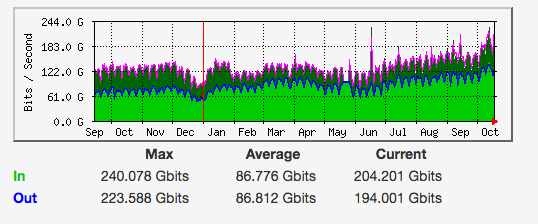
LONAP traffic up and to the right
LONAP traffic continues to grow with a new peak this month of over 240Gbps. I’d just been thinking of rattling off a quick post telling you we have broken through the 200Gigs mark at 206Gbps when lo and behold that post became instantly obsolete.
There have been 3 or 4 record levels of traffic in the last month and it can only go in one direction.
Traffic growth is being helped by some of our large eyeball and content provider members who have been provisioning 100Gbps ports this year on our new Arista based core network.
It’s such a pleasure to be involved with LONAP. A pleasure and a privilege. The team is great and the members are all great. Andy Will and I are going to be at RIPE73 in Madrid next week catching up with existing members and prospects. Look out for a little competition we are going to be running on Facebook.
Don’t forget to sign up for our Workshop and Christmas Party on 8th December. Password is lonap.
For those unfamiliar with the Internet Exchange Point world The London Access Point [LONAP] was first established in 1997 as a ‘not for profit’ Internet Exchange Point for London. Today, our list of active members includes global brands, London businesses and FTSE100 companies, all of which are joint stakeholders in the organisation. As members, they all have exclusive interconnectivity and direct input into the configuration of the network and enjoy the commercial, operational and social benefits of working with a vibrant and dynamic exchange.
Our growing membership includes ISPs, network operators and content providers with their own data networks. LONAP members exchange traffic using a network of interconnected switches hosted in our data centres across the City of London and Docklands.
Ciao amigos. See you in Madrid?
other peering posts on trefor.net
voip interop testing made easy?
I’d be interested in chatting to anyone out there who has to periodically does voip interop testing to certify equipment after a firmware upgrade. You may be an IP telephony handset manufacturer or a vendor of other equipment that needs to be certified against an operator’s platform or network.
This could be the subject of a future trefor.net workshop. The whole process, which has traditionally been quite expensive because of the time it took to perform manual testing of sometimes hundreds of features is ripe for automation.
If you use a voip call simulator such as Dory this is fairly straightforward but I wouldn’t mind hearing how others do it.
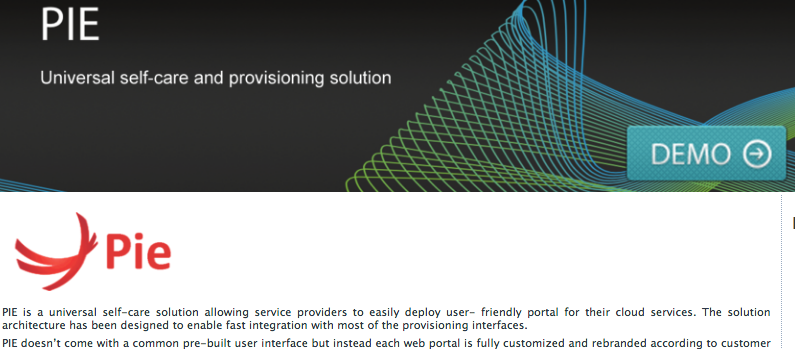
Broadsoft provisioning server – PIE by Netaxis
Broadsoft would appear to be the leader in the hosted PBX market. The problem with this is that many Broadsoft based hosted VoIP services will have little to differentiate themselves from the competition. It is a situation reached in the mature on premise market many years ago.
Their customer portals all look the same. The features are all the same. This might be ok from a customer’s perspective but it’s quite likely that all the service providers will be able to do is compete based on price. Broadsoft is not known for its cheap licensing so the point so going to come where provider margins are going to be squeezed and squeezed.
The industry is already consolidating. The biggest problem with consolidation from a VoIP perspective is how to transfer acquired customers over to your own platform. A huge amount of project management is going to be involved with some subscribers needing to be individually managed across. The setup and feature set of the new system need to be identical to the old or you risk upsetting and losing a customer.
The proliferation of Broadsoft does to a certain extent remove this problem. The features of both platforms are likely to be identical so the migration should be straightforward.
Most service providers will not have the resources to be able to customise their customer front ends – what the customer sees when they log into their online account. This is where the Netaxis PIE server comes in. PIE makes the provisioning of new customers simpler and offers customers a differentiated, simpler User Interface. From the service provider this also comes at a cost significantly lower than the Broadsoft product.
Moreover PIE comes with multi country support so if you are planning to offer services in France and Germany (for example) then you can do so in the language native to that country.
Gimme a shout if you want to hear more about PIE or see a demo.
Ciao amigos.
Disclosure. I am doing some consultancy work for Netaxis. I wouldn’t however write something about their products and solutions if I didn’t think they were good.

Look out UK – weak pound driving tech sector inflation and unemployment
The news this morning about Tesco no longer stocking Marmite in its online store due to wholesale price hikes prompted a Facebook discussion on price rises in the tech sector with pals in the industry.
Looks to me like we are in for some serious inflation driven by the weakening of the pound. Companies are already cutting back on jobs. See the comment threads – I’ve removed names and will add more inputs as I see them:
- Pricing on memory and SSDs has all increased recently as disties ran out of “pre-brexit” stock. They’ll go up again shortly with the latest devaluation as well.
- We’re now paying 25% more for most domains, ssl certs, software licenses etc. etc.
- I did a quote about a month ago, thinking I was reasonably safe for a while using a USD rate of 1.2 (Was 1.34 at the time I think), as there was a lot of licensing in it. How wrong I was.
- Yes, we have an interesting mix. One provider where we pay a percentage of list price (which is in USD). Those quotes used to be valid for 30 days, now the quote is effectively in USD and the price we pay is converted at the time the order is placed. A different provider gave us a GBP based price book with year-on-year cost erosion. We’re unlikely to be able to …and yes, I’m having to do major upgrades based on a budget placed 18 months ago where most of the kit is from the first provider above.
- Subscription services paid for in $. MS365, adobe cloud, anything like that.
- Dell did a 15‰ across the board rise
- We’ve revised our USD wholesaled domains twice and might have to do so again. In April .com was £9.17+VAT, today it’s £11.67+VAT – a 22% rise.
- My sat phone is paid in $, so that
- Not just RAM/SSDs Dell/Supermicro (via Boston) are around 20-30% more expensive for the entire system unit.
- Virtually everything for Media Production (apart from some camera mounting kit and a few audio bits and pieces) comes from Japan or the USA, so list has gone up 10% to 14%
- Snom phones went up.
- We’ve just jacked our prices up by 25% across the board as most of our products are imported and paid for in USD.
- Had a meeting about buying a new fancy instrument. “We have a Euro and Dollar price, there isn’t a sterling price as it’s too unstable.”
- After Cisco hiked prices significantly we had to decide between massively scaling back an upgrade or not hiring a new engineer. Whoever says the impact is not losing jobs is deluded. There’s a intelligent motivated young man who is currently unemployed, who wouldn’t be if it wasn’t for the cost rises.
- I’m being hit with SSD price rises 🙁 At one point 120gb sandisk SSD’s were £31, last time I bought they were £40. They are now £39 on Amazon.
Also the Wifi AP I bought in June for £108 is now £111 – THE CHEEK! 😀 - Our situation: we were buying for an expansion to Geneva just around the time of EUref. Only a few bits of kit were ~5% more expensive, but I could see prices going up almost daily on anything imported. Of course, having installed it all now, colocation costs abroad are obviously feeling more and more expensive. We planned our budget assuming Brexit and GBP-crash, and also our colo supplier there allows pre-pay on their customer accounts — which we did! https://twitter.com/maznu/status/786538777816788992
On a personal note my google drive costs are paid in dollars so my cloud storage costs will already have risen.
update from a vendor:
“it should be pretty common knowledge that “price rises are coming to a vendor near you”. All components are priced in USD, most IT and networking equipment is imported, so it’s inevitable. There may be long term sourcing agreements that mean vendors suffer, but they will need to recover that lost margin from somewhere (meaning those customers without long term pricing agreements in GBP). I don’t see any upsides. Even UK manufacturers aiming to export will struggle with all their components priced in USD. The general effect will most likely be that customers used to getting 10%, 20% more off the initial quoted price will struggle if they make an assumption that will continue.”
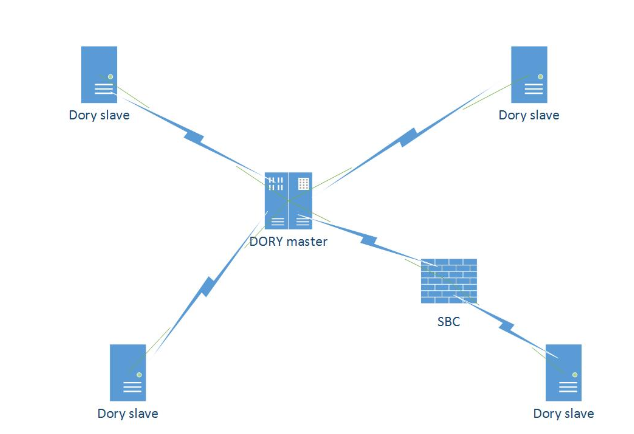
Call simulator finds problems before your customer
Dory call simulator can be used to quickly certify new firmware releases on CPE such as PBXs or to stress test a network after upgrades to carrier platforms.
Some of you will know I’ve been doing some consultancy work for a Belgian outfit called Netaxis Solutions. Netaxis develop software that is used by telcos around the world to help run their networks.
Recently I’ve been looking at their Dory call simulator. I hadn’t quite sussed how useful these thing are. If you are performing upgrades to your hosted platform then the ability to run stress tests overnight before your customers come in in the morning could save you a lot of angst. An upgrade that at first appearance seems to have been successful isn’t really tested until the network is carrying lots of calls. If you can avoid it (and I know from bitter experience) it’s better not to have your customers perform the stress tests on your behalf. What price peace of mind.
The Dory call simulator can be setup to initiate multiple calls per second and build scenarios that replicate real life situations. It empowers you to decide whether to roll back an upgrade before it is customer affecting.
The other cool feature is Dory’s ability to test CPE such as PBXs. If you provide SIP trunks to your customers then the likelihood is that these customers will use a wide variety of equipments at the end of the SIP trunk. The more the type of kit the bigger the support headache. Most operators don’t have the luxury of being able to constrain their customers to a small number of supported CPE.
The problem is every time a vendor upgrades their firmware this kit has to be recertified on your network. This is an expensive and time consuming process. Imaging it it could be automated. Well this is what Dory does.
You can easily construct scenarios that match all the call types handled by a piece of equipment. Call transfer, hold, hunt groups etc etc. You build up your library of scenarios and every time an interop test needs running you just point Dory at the kit and hey presto, it runs the tests.
There is a little more to it than this but you get the drift. Dory comes with a console, a scheduler and logger, can simulate both inbound and outbound calls and can be run as multiple instances around your network. I have some spiel/data so if you want to know more feel free to get in touch. Also if you think you would like a demo you can request it from the Netaxis Dory page on their website.
Ciao.

